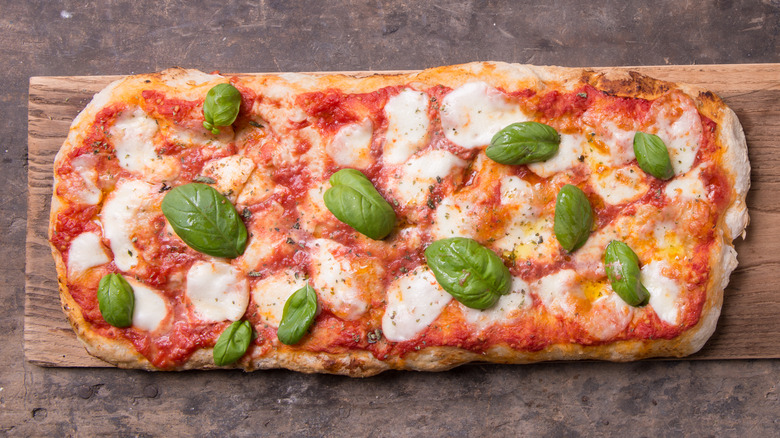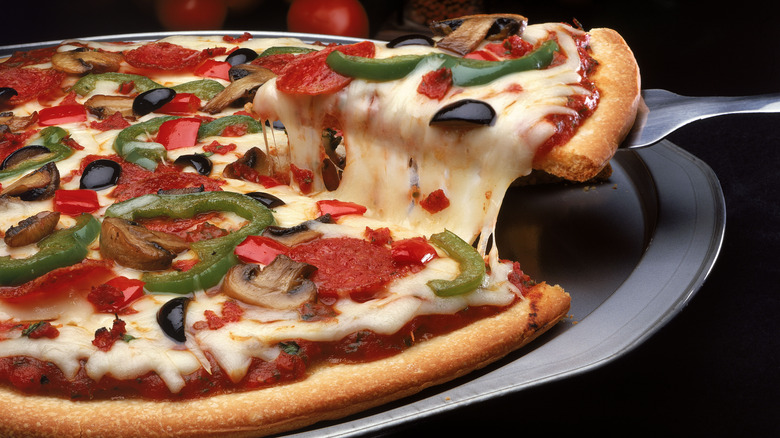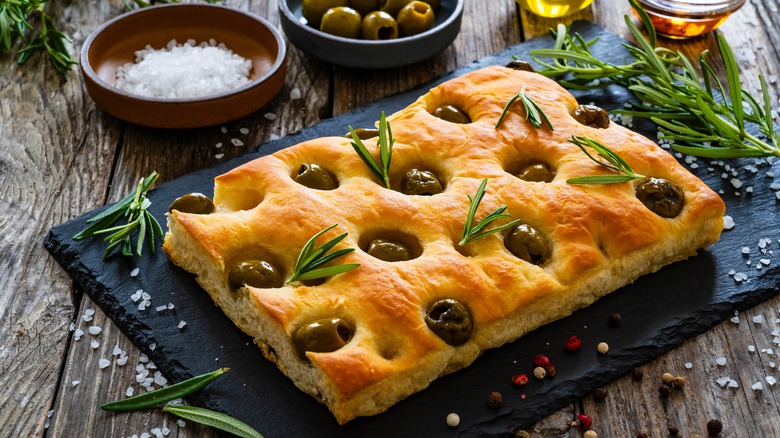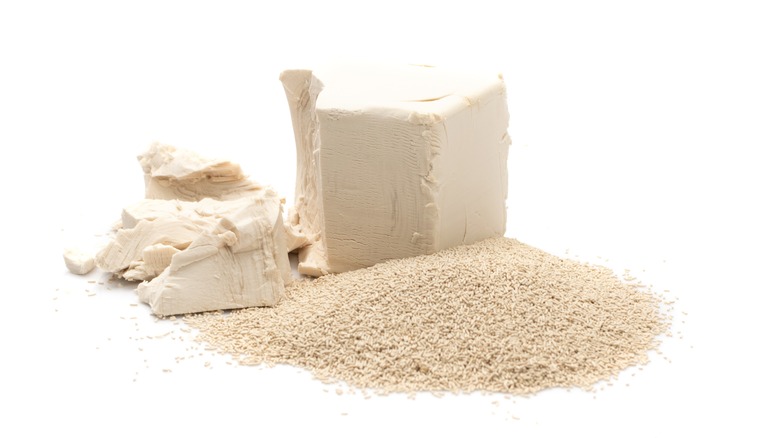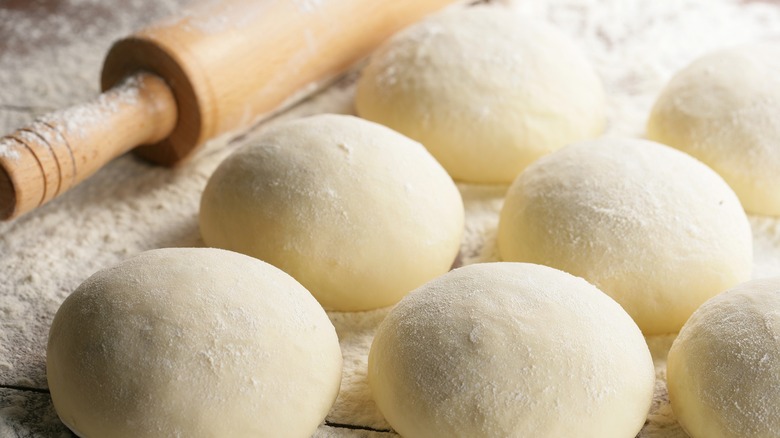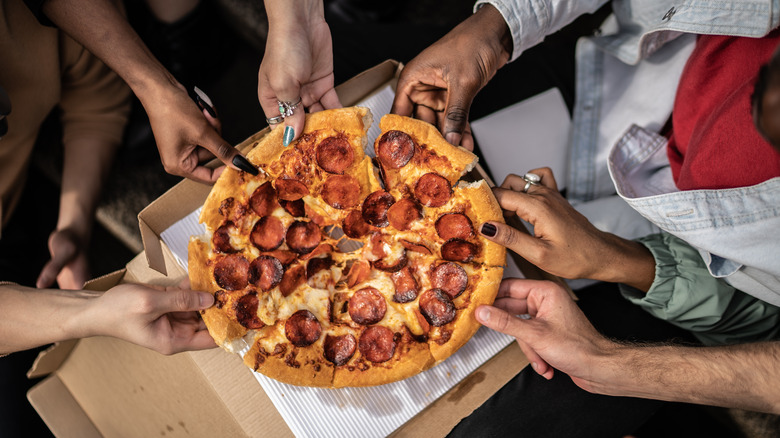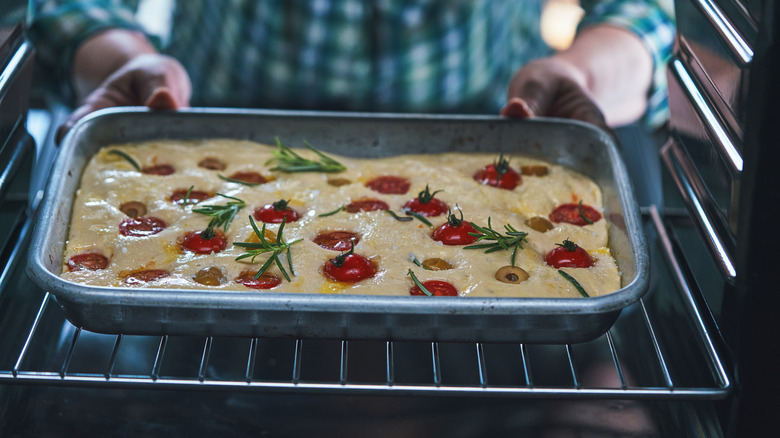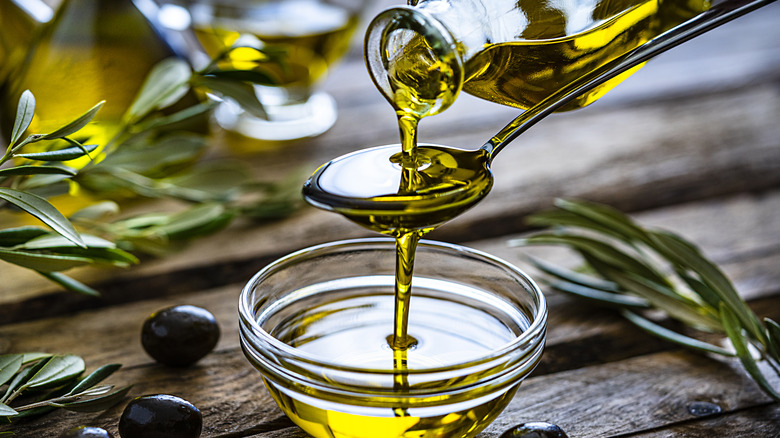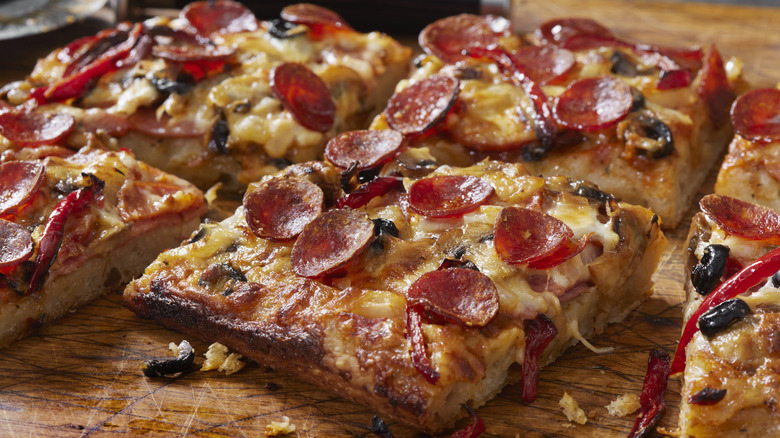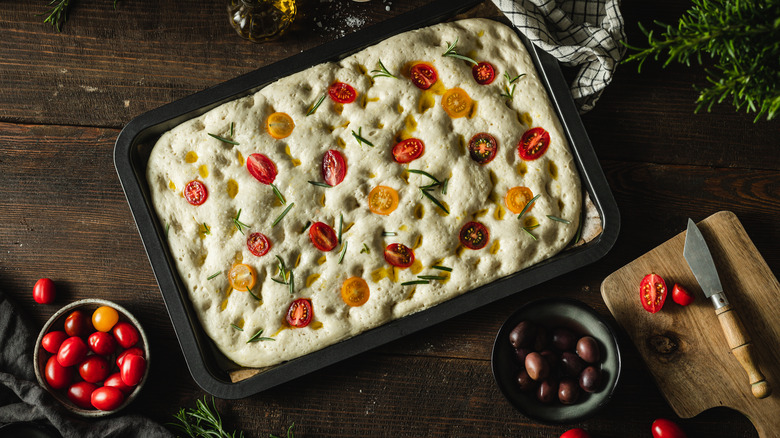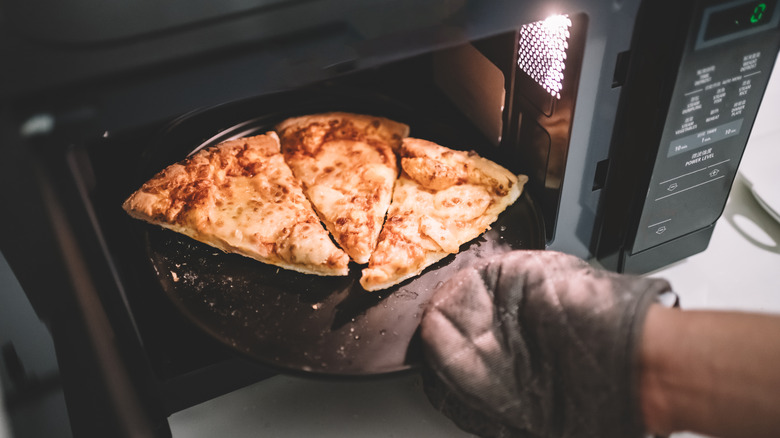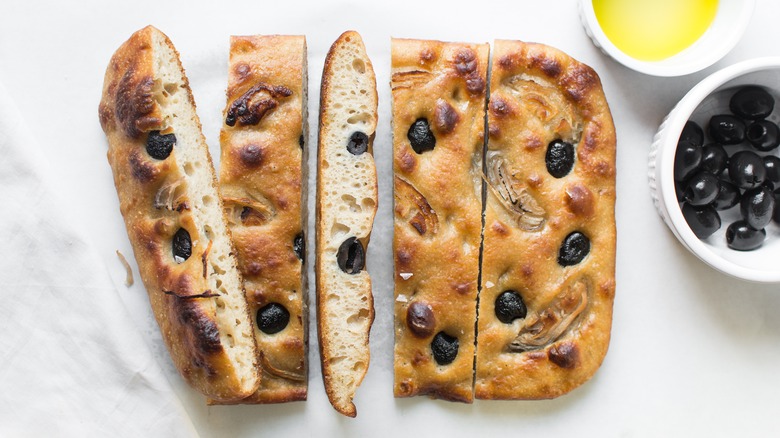Pizza Vs Focaccia: Everything You Need To Know
As an American living in Italy, I can tell you that the rumors are true: There is a lot of pizza over here. Pizza is both made at home and eaten at restaurants on a weekly (at least) basis, which means I have gotten to know this delightful flatbread a lot better than I ever knew it before. But just when I thought I had become a master of pizza eating and making, they threw me a curve ball: focaccia.
I had heard of focaccia, pizza's plainer but no less delicious sibling, but I had always believed it was basically just bread with some olive oil on it. This is not the case. Sometimes focaccia can be served with toppings too, leading me to ask, on more than one occasion, "Are we eating pizza or focaccia?"
The two really do have a lot in common, but there are some key characteristics that set them apart. In this article, we're going to dive into both so that you, unlike me, will never have to wonder which one you are eating.
What is pizza?
Pizza is so popular in Italy, the U.S., and around the world that I probably don't have to tell you what it is, but you may be interested to know its origin story. Pizza, a dish composed of a flat, round disk of bread typically topped with sauce, cheese, herbs, vegetables and/or meat, has been eaten in some form or another since ancient times. It was enjoyed by not just the Romans, but the Greeks and the Egyptians too. But pizza as we know it specifically is credited as coming from Naples.
In the 1700s and 1800s, Naples was a big, busy city where many people were poor and most were in a hurry. They needed something to eat that was quick and cheap to make: pizza. Back then, they were eating flatbreads with toppings like tomatoes, oil, cheese, garlic, and anchovies — not really much different from today. This dish was so delicious that it was even enjoyed by the visiting queen of Italy, Queen Margherita, whose love of a mozzarella pizza with tomatoes and basil led to it being named after her.
American and Italian pizza are fairy different, however. This distinction was born in the 1940s when pizza made its way to America, thanks to immigrants moving there from Naples. As with the first pizzas made centuries earlier, they became popular thanks to their quickness. But soon everyone, even other immigrants and American citizens, were drawn in by the tantalizing smell. The rest, as they say, is history.
What is focaccia?
While most of us are pretty familiar with pizza, not everyone has eaten focaccia. This Italian bread is characterized by its tall, fluffy appearance and its non-negotiable coating of olive oil. You may also recognize it for the characteristic dimples spread throughout its surface, which collect all that tasty oil.
Like pizza, focaccia has been around since ancient times. It is believed to have been developed by the Etruscans in and around the area that we now know as Italy. In the beginning, focaccia was made without yeast, using just flour, water and salt. The dough was spread flat on a stone and cooked under hot ashes, which is why it was referred to as panis focacius, meaning "hearth bread." Nowadays, things are a lot simpler, as it's just baked in the oven.
In America, focaccia is fairly easy to spot, as it's simply referred to as focaccia. But in Italy, things can get a little trickier. There, it can also be called pizza Genovese, meaning a pizza that is typical of Genoa, where they refined and improved the recipe. Focaccia is not as ubiquitous as pizza in the United States (or in Italy), but it has enjoyed a recent surge in popularity, so it's no longer seen as just a more obscure form of pizza.
Pizza uses less yeast
Both pizza and focaccia are flatbreads, made with the same ingredients (flour, water, and yeast) and (potentially) crowned with toppings. So how can you tell them apart? Is focaccia just a different type of pizza? No — these two creations are actually more different than they might seem at first glance.
The main difference between focaccia and pizza is that focaccia dough uses more yeast. This results in a light, airy texture fairly similar to regular bread. Pizza dough includes yeast too, but as it is meant to be a shorter, firmer base for heavier toppings like sauce and cheese, it does not use as much.
Foccacia also requires more rising time. While both start out as a ball of dough that has to rest and grow for several hours, their preparation methods diverge when it comes time to spread them in the pan. Usually, once pizza dough is pressed into the pan, it's ready for toppings and to be put in the oven. Focaccia, though, is spread in the pan and left there to rise for a while longer to achieve a softer, fluffier final product.
Focaccia dough is more moist
The ingredients in pizza dough are flour, water, salt, and yeast. The ingredients in focaccia dough are flour, water, salt, yeast, and olive oil. Not much difference there, right? Actually, there is.
You can tell the difference between focaccia dough and pizza dough by the fact that the former is looser and contains more moisture. Pizza dough will be firmer and hold its shape more, while focaccia dough is more likely to stick to your hands. This difference also leads to a difference in baking methods. Focaccia is best cooked with some steam. If you have an oven with a pre-steam function, you should use this to fill the chamber with steam for 3 minutes before baking the focaccia at 465 degrees F for around 30 minutes. If your oven does not do this, you can add a tray with water in it to the bottom of the oven to provide steam.
Pizza, on the other hand, is traditionally baked in a brick oven, but can also be baked in a normal oven at 400 degrees F. It doesn't take as long to cook, and should be ready in 8 to 12 minutes.
Pizza is a main course
One of the more minor differences between pizza and focaccia is that pizza is more of a meal. Thanks to toppings like sausage, cheese, eggplant, pepperoni, or any of the million other options that are out there, this hearty dish can be a full lunch or dinner on its own. Focaccia, though, is usually a side dish, part of a larger meal, or even just a snack. In Italy, for example, I have seen it served in small squares as part of a course of antipasti, even in very elegant restaurants.
While I wouldn't go so far as to equate focaccia with regular bread, garlic bread, or even American breadsticks, which are all served as a (sometimes barely noticed) side to a meal like spaghetti, it is fair to say that focaccia is not normally a meal in and of itself. It is rarely served with another type of dish like meat or pasta, though. For the most part, it is served right alongside pizza, giving diners the best of both worlds.
Focaccia is usually rectangular
This one may seem a little obvious, but telling the difference between two similar things always starts with sight. In this case, if you look at pizza and focaccia side by side, you will clearly notice that pizza is round (in most cases). In the U.S., that round pizza is always cut into triangular slices before serving, but in Italy, each person is usually served an entire pizza, which they can cut into triangles themselves and eat with their hands or a knife and fork.
Focaccia, on the other hand, is always rectangular and cut into smaller rectangles or squares for serving, which shows off the airy crumb between its upper and lower crust. These squares are usually taller than pizza slices (depending on how high they pile up the pizza toppings, anyway), but are always eaten by hand. Keep a napkin handy, though, because focaccia is pretty oily!
Focaccia always has olive oil
One of the main ways people tell pizza and focaccia apart is by simply noticing that pizza has sauce, but focaccia has olive oil. It should be noted that this isn't foolproof, in the case of classic white pizza; a white pizza is one with toppings, but no sauce. Focaccia, however, always, always has olive oil.
While some bread is served dipped in olive oil, this is not the case with focaccia. Focaccia has the olive oil baked in. After spreading the dough in the pan, bakers let it rise again. Then, they create dimples in the dough and douse the whole thing with olive oil before putting it in the oven. Don't be shy here, if you're making your own. We're not looking for a drizzle of oil, we're looking for a sea of it that pools in the indentations and flavors the entire thing. From here, coarse salt, herbs, or other toppings are added. But without that olive oil, focaccia just turns into regular bread or a bare pizza crust.
Pizza has more toppings
After the shape, the most noticeable difference between pizza and focaccia is the fact that the former has more toppings. Typically, pizza has a tomato-based sauce with herbs and spices, which can be dressed up in many ways. If you want to keep it simple, there is cheese pizza or margherita pizza, both of which only have mozzarella on top. If you want to get a bit more creative, you can add vegetables like bell peppers, mushrooms, potato, or even lettuce and tomato. If you're more of a meat eater, you can add sausage, pepperoni, ham, chicken, salami, tuna, or anchovies for starters. Heck, you can even add pineapple if you really want to (just don't tell the Italians).
Focaccia can have toppings too, sometimes to the extent that it seems an awful lot like pizza, save for the height of the crust. Focaccia occasionally has cheese and vegetables (though not usually meat), but this is a rarity. Most often, its toppings are more sparse and arranged differently. Three popular types of focaccia are tomato focaccia, olive focaccia, and onion focaccia. Tomato focaccia features cherry tomato halves or sun-dried tomatoes pressed into the dimples of the dough before baking. Olive focaccia uses half olives in the same way. Onion focaccia — you guessed it — is distinguished by the onion pieces scattered across its surface. The focaccia then rises in the oven and grows up around these vegetables, making them less like toppings and more a part of the bread.
Focaccia has dimples
Dimples aren't just for faces — they're also for focaccia! After kneading and spreading the dough in the pan, it is essential to make dents in the surface of your focaccia. This process is called "dimpling," and it serves two purposes. The first is to release the excess air that may have built up during the handling of the dough and its rising. If left as they are, these air pockets would burst during baking and make the bread fall. The second reason is more of a perk: The dimples create a place for olive oil to pool, or a place to put toppings.
It doesn't take much to master dimpling. All you have to do is get some olive oil on your fingers and press them into the dough, deep enough to make profound dents, but not quite deep enough to touch the pan. You can also use the handle of a wooden spoon if you don't want to get your hands dirty, but half the fun of cooking is getting messy, so I advise against it.
Pizza reheats better
Focaccia is cool and all, but there is one category in which it can't even come close to beating pizza: leftovers. Leftover pizza can be just as yummy the next day — or sometimes even a bit better — as it was the night you first made or bought it. Plus, there are as many ways to reheat pizza as there are types of pizza. You don't even have to reheat it if you don't want to, though: It can taste good heated up and cold from the fridge.
Focaccia isn't so lucky. Fresh-from-the-oven focaccia is delicious, but leave that focaccia on the counter for just a few hours and it already starts to change consistency and flavor. It gets harder and chewier, and by the next day, you might feel like you're trying to eat a brick. This is not improved by reheating it — in fact, that could just make it worse.
So, when it comes to focaccia, it's best to eat it as soon as you can. When it comes to pizza, you have more time and more options, like reheating it in the oven, the air fryer, the toaster oven, or, if none of those options are available, the microwave. To avoid your microwave turning your crust chewy, put a mug of water beside your pizza slice while you microwave it.
Focaccia doesn't need to be refrigerated
Storing both focaccia and pizza is fairly straightforward. Unless it's one of the rare batches that has cheese on top, focaccia can be stored at room temperature. Simply place it in a Ziploc bag and press to remove the air. Or, if you're out of bags, you can store it in an airtight storage container on the counter. Either way, though, be aware: No matter how well you store it, it will not taste as good the second day, as focaccia is meant to be eaten fresh.
Unlike focaccia, pizza has dairy or other toppings that can spoil. It should not be left out at room temperature for more than two hours, but it can be stored in an airtight glass or plastic box in the refrigerator (not the cardboard box from the pizza place) for up to four days. It can also be wrapped tightly in tin foil. You can freeze it for up to two months as well, as long as you wrap it in plastic wrap or foil. If either your focaccia or your pizza starts to change color or smell bad, it's time to throw it out.
